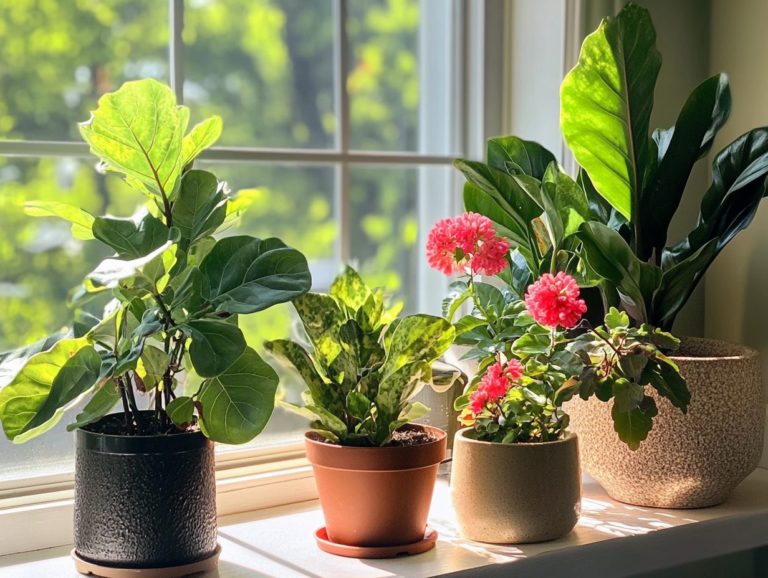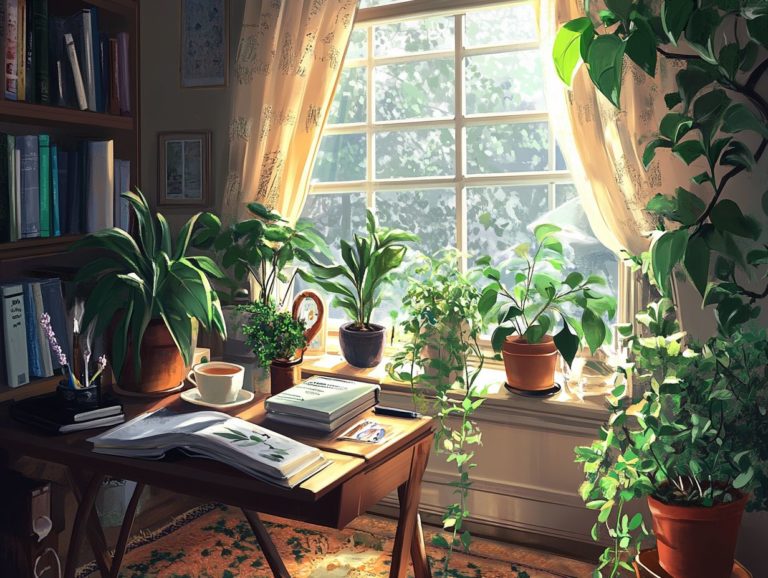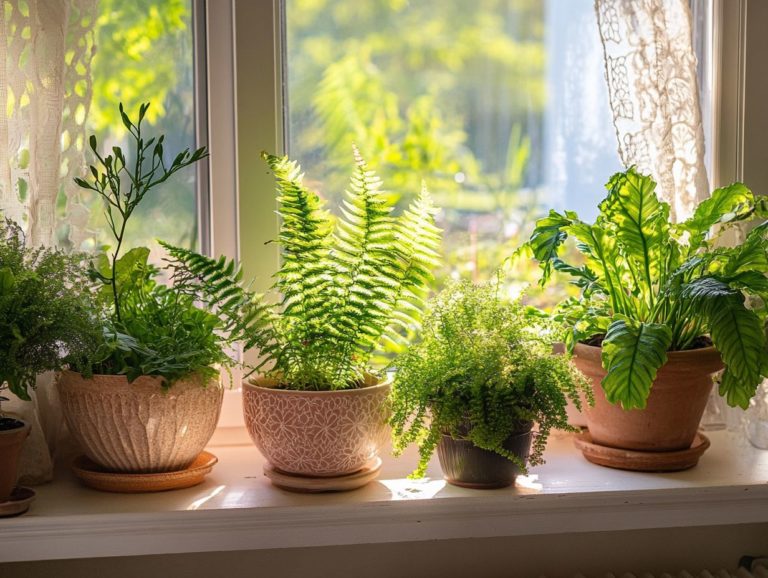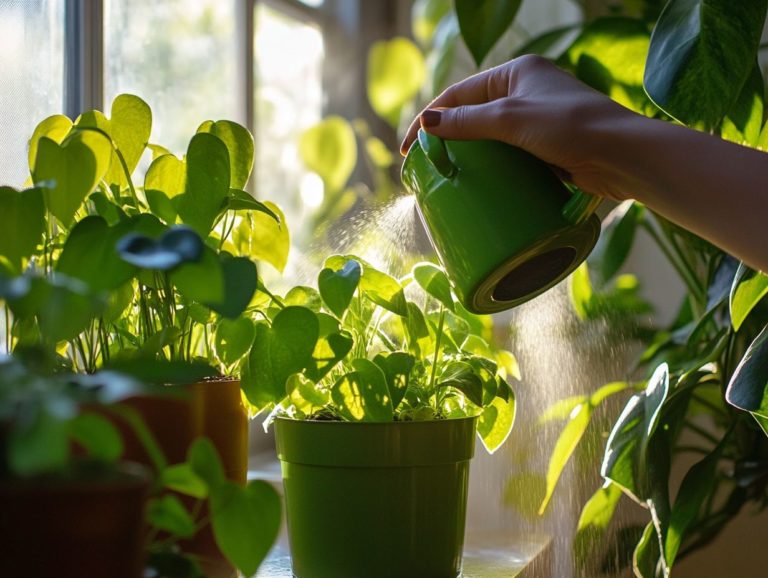The Best Indoor Plants for Unique Spaces
Transforming your indoor space with greenery can be a truly rewarding and rejuvenating experience.
No matter if you’re dealing with limited square footage, sunny windowsills, or those quirky little corners, there’s a plant perfectly suited for every nook and cranny in your home.
From whimsical hanging plants that breathe life into small spaces to resilient succulents flourishing in low light, this guide will help you explore the best indoor plants tailored to your environment.
Discover how to elevate your home or office with the ideal foliage, all while considering your unique lifestyle and space constraints.
Contents
- Key Takeaways:
- 1. Hanging Plants for Small Spaces
- 2. Succulents for Low-Light Areas
- 3. Air-Purifying Plants for Offices
- 4. Edible Plants for the Kitchen
- 5. Climbing Plants for Vertical Spaces
- 6. Large Plants for High Ceilings
- 7. Low-Maintenance Plants for Busy Individuals
- 8. Plants for Bathrooms and Humid Environments
- 9. Fragrant Plants for Bedrooms
- 10. Plants for Pet-Friendly Homes
- 11. Plants for Dark Corners
- 12. Plants for Windowsills
- 13. Drought-Resistant Plants for Dry Climates
- 14. Plants for Bookshelves and Desks
- 15. Plants for Unique Containers
- How to Choose the Right Indoor Plants for Your Space
- Frequently Asked Questions
- What are the best indoor plants for small spaces?
- Can I grow indoor plants in low light areas?
- Which indoor plants are best for hanging baskets?
- What are the best indoor plants for purifying the air?
- What are some unique indoor plants for adding texture to a space?
- How can I incorporate indoor plants into a small bathroom?
Key Takeaways:
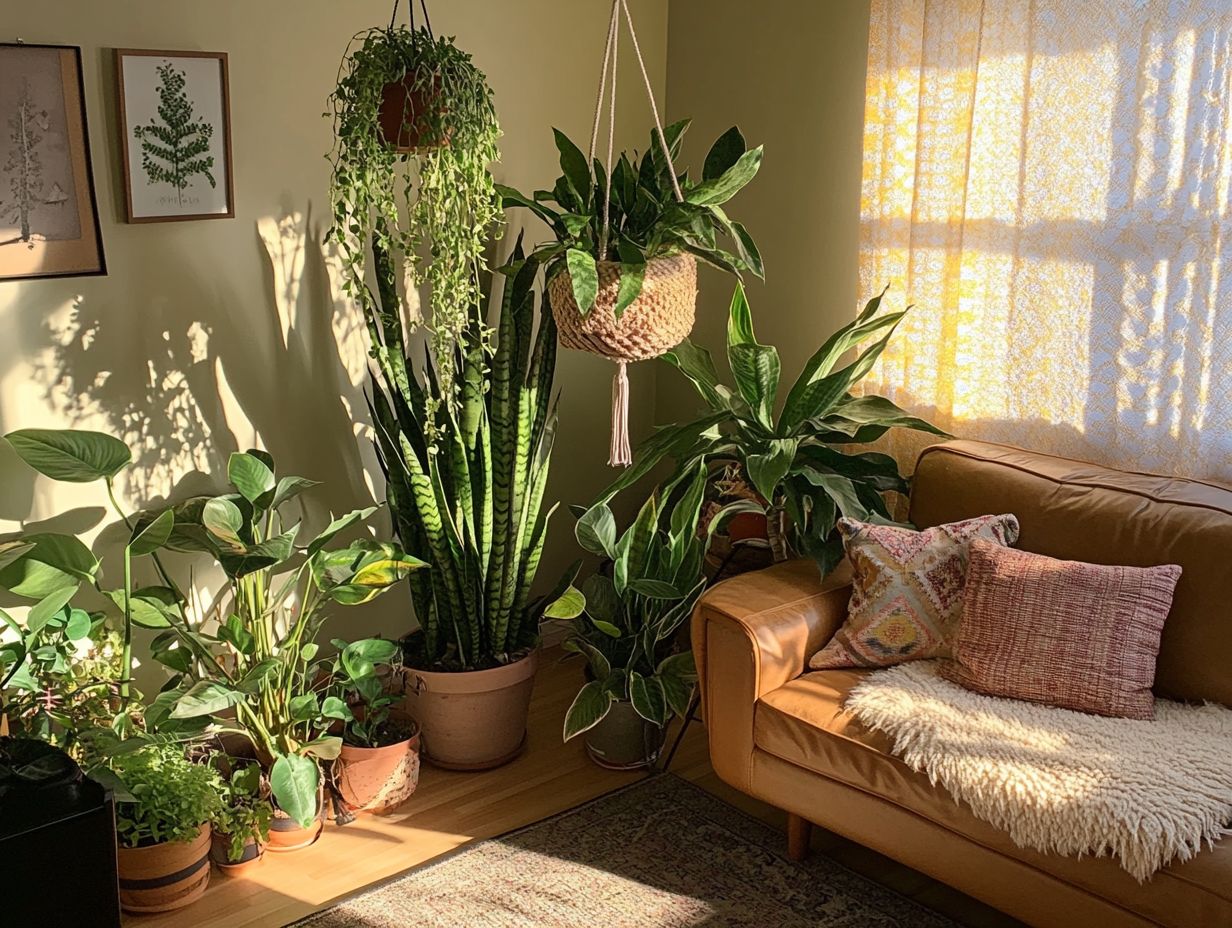
- Opt for hanging plants to save space in small areas!
- Succulents thrive with little care in low-light spots!
- Air-purifying plants boost office air quality!
1. Hanging Plants for Small Spaces
Hanging plants are perfect for small spaces. They enhance your indoor greenery without sacrificing floor space.
These plants are ideal for apartment living or cozy homes where every inch counts.
From the vibrant Pothos to the elegant Tradescantia, these space-saving plants elevate your decor and improve indoor air quality.
When choosing hanging plants, select varieties that thrive in bright, indirect light and require minimal maintenance. This way, your home becomes a lush sanctuary without the burden of exhaustive houseplant care.
The Spider Plant stands out with its striking arching leaves and impressive air-purifying qualities. It prefers slightly moist soil and indirect sunlight, making it adaptable to various areas of your home.
The ZZ Plant is also a great option, known for its glossy foliage and resilience. It thrives with minimal watering and effortlessly tolerates low light and dry conditions.
For optimal growth, hang these plants where they can bask in adequate light but remain shielded from direct sun.
Try misting them now and then or using a pebble tray for added moisture, especially in drier climates.
Implement a consistent watering schedule. Allow the topsoil to dry out between sessions to prevent root rot, which happens when plants get too much water and start to decay.
2. Succulents for Low-Light Areas
You ll love succulents for those low-light areas in your home! They thrive in less-than-ideal conditions and showcase stunning decorative foliage.
Whether you’re a novice or a seasoned plant enthusiast, their easy-going nature makes them incredibly appealing.
The Aloe Vera is a standout, renowned for its medicinal properties and its adaptability to dimly lit spaces.
The ZZ Plant is celebrated for its glossy leaves and remarkable tolerance for neglect. These succulents thrive on a careful watering schedule; infrequent hydration is crucial for their survival.
When cared for properly, these plants do more than just beautify your space they enhance indoor air quality by filtering out toxins and breathing life into those shadowy corners of your home.
3. Air-Purifying Plants for Offices
Incorporating air-purifying plants into your office space elevates the aesthetics and significantly enhances indoor air quality.
This is especially crucial in urban settings rife with pollutants.
Consider welcoming green companions like the Peace Lily and Rubber Plant into your workspace. These plants require minimal maintenance and thrive in areas with limited natural light.
The Peace Lily, adorned with its elegant white blooms, is renowned for filtering harmful toxins from the air. It needs just an occasional drink of water to flourish.
On the other hand, the Rubber Plant is a true champion of resilience, adapting effortlessly to indoor conditions while offering striking visual appeal.
Both plants are ideal for the busy professional who may not have the luxury of time for high-maintenance greenery yet still seeks a vibrant workspace that fosters well-being.
4. Edible Plants for the Kitchen
Edible plants for your kitchen do more than provide fresh ingredients for culinary masterpieces; they also add a charming touch of greenery to your cooking space, enhancing both aesthetics and functionality.
Incorporating herbs like basil, mint, and chives into your indoor gardening routine can be rewarding. Imagine cultivating fresh flavors just steps away from your stovetop. These beloved plants thrive in bright, indirect light and appreciate humidity levels around 40-60%. Regular watering and proper drainage help maintain their health and vibrancy.
Snipping fresh mint to elevate a drink or adding aromatic basil to a pasta dish transforms everyday cooking into an inspired experience, sparking creativity in the kitchen.
5. Climbing Plants for Vertical Spaces
Climbing plants maximize vertical spaces by transforming bare walls into lush vertical gardens. They enhance the aesthetic appeal of your indoor environment and create a sense of tranquility with their decorative foliage.
Favorites in the climbing plant world include Monstera, known for its unique leaves, and Arrowhead Vine, which adds a distinct flair to any space. Both thrive in bright, indirect light and appreciate humidity, making them perfect for moderate climates.
For installation, consider using trellises, wall-mounted grids, or hanging shelves to support their growth. Regular pruning encourages bushier growth and keeps them neatly contained. A simple routine of watering and fertilizing keeps them vibrant and healthy.
Embracing these climbing plants elevates your interior design and nurtures a calming green oasis in your home.
6. Large Plants for High Ceilings

Large plants are ideal for spaces with high ceilings, serving as striking focal points that add depth and character to expansive interiors with their lush, tropical foliage.
Options like the Fiddle Leaf Fig, with its broad, glossy leaves, or the tall Dracaena, known for its dramatic height, are excellent choices. Understanding how to care for them is essential for thriving plants.
The Fiddle Leaf Fig thrives in bright, indirect light and needs occasional watering to maintain humidity. In contrast, the Dracaena adapts well to lower light conditions, making it versatile for various corners of your room.
Both plants create visual interest, drawing the eye upward and complementing your decor, transforming expansive areas into cozy and inviting spaces.
7. Low-Maintenance Plants for Busy Individuals
For busy individuals, low-maintenance plants offer the perfect way to add life to your space without intensive care. Cultivating a vibrant home environment takes minimal effort.
The Snake Plant and ZZ Plant are top contenders, celebrated for their remarkable resilience. The Snake Plant thrives in low light to bright indirect sun, making it adaptable to almost any corner of your home. With a simple watering schedule every two to three weeks, it prefers to dry out between waterings.
Similarly, the ZZ Plant is nearly indestructible, thriving in low light and needing water only when the soil is completely dry. With these easy-care options, you can maintain a lush, green environment with minimal time and effort, allowing you to enjoy the benefits of indoor greenery without stress.
8. Plants for Bathrooms and Humid Environments
Choosing plants for your bathroom or any humid environment can turn your space into a calm, relaxing area that thrives in moisture-rich conditions. These plants enhance decor and improve indoor air quality.
When selecting the right varieties, options like the Staghorn Fern and Spider Plant truly shine due to their adaptability. The Staghorn Fern has distinctive, antler-like fronds and thrives in high humidity, making it perfect for a bathroom with limited light.
The Spider Plant brings a lively touch to the atmosphere. It can easily tolerate lower light conditions.
To ensure these plants flourish, maintain humidity levels between 50-70%. Avoid direct sunlight, as it could scorch their delicate foliage. By doing so, you ll create a thriving indoor garden that elevates your space.
9. Fragrant Plants for Bedrooms
Incorporating fragrant plants into your bedroom elevates decor and encourages relaxation, enhancing sleep quality with delightful natural scents.
Among these, Lavender shines with its calming properties. It s known to reduce anxiety and improve overall sleep patterns.
Jasmine offers a sweet aroma that uplifts your mood and fosters tranquility.
To care for these plants effectively, ensure they receive adequate sunlight while keeping the soil moisture balanced. Position them near windows to optimize scent diffusion, allowing fragrant oils to permeate the room effortlessly.
Together, they create a peaceful environment, transforming your bedtime into a more restful experience.
10. Plants for Pet-Friendly Homes
Selecting plants for your pet-friendly home is crucial for ensuring a safe environment. Choose indoor greenery that is non-toxic and enhances your decor.
Species like the Spider Plant and Boston Fern make transforming your living space with vibrant greenery a worry-free endeavor. These plants thrive in various indoor conditions, making them perfect companions for you and your beloved pets.
The Spider Plant has elegant arching leaves, enjoys indirect sunlight, and requires occasional watering. The Boston Fern flourishes in humidity and prefers shaded spots.
Both options allow you to keep your home stylish and welcoming without sacrificing the safety of your cherished furry friends.
11. Plants for Dark Corners
Brighten up those dark corners of your home by incorporating plants that thrive in low-light conditions. You can breathe life into areas that might otherwise go unnoticed.
Among the best options are the Cast Iron Plant and the Snake Plant, both renowned for their remarkable resilience and minimal care needs. These hardy companions excel in shady spots, making them ideal for dimly lit rooms.
Ensure the Cast Iron Plant has good drainage and enjoy occasional watering. The Snake Plant can happily tolerate infrequent watering and thrives on a bit of neglect.
Consider placing these plants on shelves or side tables to enhance their visual appeal. Rotate them periodically for balanced growth. With these straightforward care tips, they can flourish effortlessly, adding a touch of nature to any corner of your home.
Don t miss the chance to enhance your home! Choose the right plants today and watch your space come alive with nature!
12. Plants for Windowsills

Using your windowsills for plants can turn them into a stunning display of greenery. This not only looks great but also improves the air quality in your home.
Consider plants like the Fiddle Leaf Fig. Its large, glossy leaves thrive in bright light but need extra care with humidity and watering.
The Pothos is another excellent choice. It adapts easily to different light conditions and trails gracefully over the edge of a shelf.
Place these plants close together to maximize their light exposure in the sunniest part of your windowsill. Arranging the taller Fiddle Leaf Fig behind the cascading vines of Pothos adds depth and interest to the display.
13. Drought-Resistant Plants for Dry Climates
Drought-resistant plants are essential for dry climates, allowing you to enjoy lush greenery while conserving water. This means you can have plants with less effort.
Succulents and cacti are among the best choices. They excel at storing water and thrive in arid conditions. Adding these hardy plants makes your outdoor spaces better and reduces the need for frequent watering.
When selecting soil, use a well-draining mix that prevents water retention. A customized watering schedule, with less frequent watering during cooler months, helps these drought-adapted varieties thrive.
14. Plants for Bookshelves and Desks
Enhancing your bookshelves and desks with plants turns your workspace into a refreshing focal point. This not only adds vibrancy but also improves indoor air quality, creating a calming atmosphere.
Incorporate versatile plants like the ZZ Plant and Peace Lily. The ZZ Plant has glossy leaves and grows well in indirect sunlight with minimal watering. The Peace Lily, with its elegant white blooms, brings visual interest while thriving in low-light conditions and cleaning the air naturally.
When arranging these plants, vary the heights and textures to create visual intrigue. Position taller plants behind shorter ones to guide the eye and achieve a captivating look.
15. Plants for Unique Containers
Using unique containers for your indoor plants can create stunning displays, allowing you to express yourself while showcasing compact houseplants.
Imagine using teacups for a whimsical touch, perfect for petite succulents or charming herbs like basil. These plants thrive with just occasional watering and indirect sunlight.
Mason jars serve as both functional and stylish options, ideal for delicate air plants that flourish in bright, filtered light.
If you’re aiming for a rustic aesthetic, reclaimed wood planters provide an earthy backdrop for vibrant orchids or tiny ferns, which appreciate higher humidity. By pairing specific plants with creative containers, you can create a cozy vibe that reflects your personal style.
How to Choose the Right Indoor Plants for Your Space
Choosing the right indoor plants for your space requires a thoughtful choice of your environment, including light levels, humidity, and your personal lifestyle needs. It s essential that your selections not only improve the look of your home but also align with the practical aspects of plant care.
Start by evaluating the natural light in your space. Identify areas that bask in direct sunlight versus those that are more shaded. Next, take note of the humidity levels. Rooms like kitchens and bathrooms tend to be more humid compared to drier spaces like living rooms or offices.
Don t forget to measure your room dimensions. This ensures you can allocate the right amount of space for your plants without creating a crowded look.
With this information, you can confidently choose low-maintenance plants that cater to a variety of lifestyles. For example, if you have a dimly lit corner, low-light champions like snake plants or pothos will thrive there. If you have a sun-drenched spot, succulents will thrive as well.
Knowing these factors will help you create a harmonious and sustainable indoor garden that truly enhances your living space.
Frequently Asked Questions
What are the best indoor plants for small spaces?

The best indoor plants for small spaces include air plants, succulents, and spider plants. These compact plants add greenery without taking up much room.
Can I grow indoor plants in low light areas?
Yes! Several indoor plants thrive in low light, such as peace lilies, snake plants, and ZZ plants. They add a touch of green to dark corners or rooms with limited natural light.
Which indoor plants are best for hanging baskets?
Some of the best indoor plants for hanging baskets include pothos, ivy, and string of pearls. Their trailing vines look beautiful hanging from a basket or macrame hanger.
What are the best indoor plants for purifying the air?
Some top indoor plants for purifying the air include snake plants, spider plants, and peace lilies. These plants help remove toxins from the air, improving overall air quality in your home.
What are some unique indoor plants for adding texture to a space?
For adding texture, consider unique indoor plants like the Swiss cheese plant, bird’s nest fern, or string of pearls. Their interesting textures add visual appeal to any room.
How can I incorporate indoor plants into a small bathroom?
Incorporating indoor plants into a small bathroom is simple. Opt for plants that thrive in high humidity, like ferns, orchids, and peace lilies. You can hang plants from the ceiling or use a small shelf to save space.
Start choosing your perfect indoor plant today!


